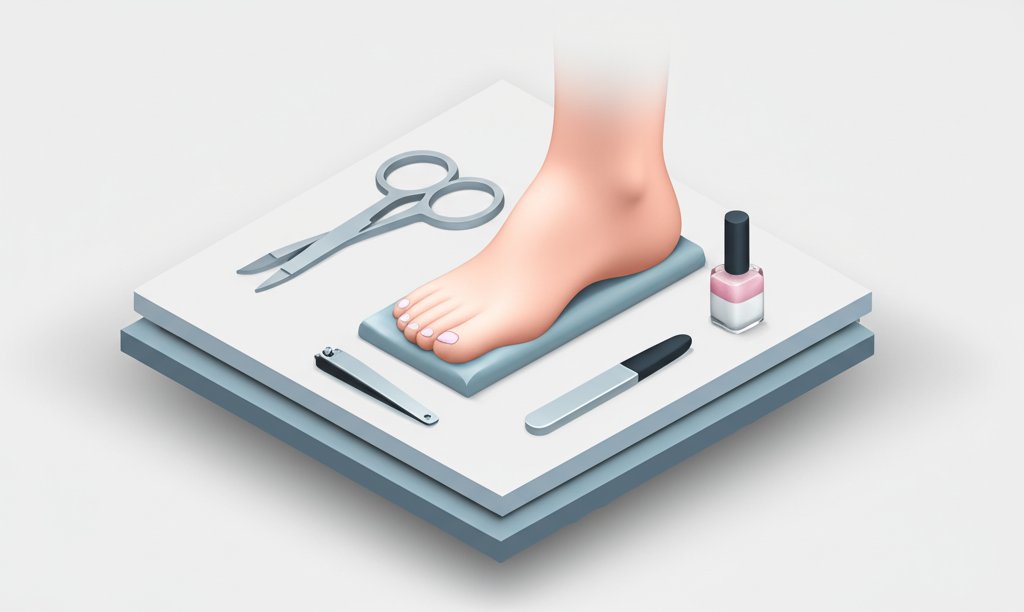Often relegated to the footnotes of our daily grooming routines, our toenails are far more than just hard coverings on our toes. They are intricate biological marvels, silent storytellers of our health, and surprising contributors to our balance and sensation. If you thought you knew everything about these unassuming appendages, prepare to have your mind blown. This article delves into a treasure trove of unusual facts, captivating toenail facts, and fascinating toenail tales that will transform your perspective on these often-overlooked body parts. Get ready to uncover the hidden world and surprising facts about toenails you never knew existed!
More Than Just Protection: The Unsung Roles of Your Toenails
While their primary role is undeniably protective, shielding our delicate toe tips from trauma, toenails secretly perform a host of other critical functions. They are silent, yet vital, components of our intricate biological machinery.
Architects of Alpha-Keratin: What Your Toenails Are Really Made Of
At their core, toenails are primarily composed of a tough, fibrous protein called alpha-keratin. This same protein forms our hair and the outer layer of our skin, highlighting its role as a fundamental building block of our integumentary system. But it’s not just a simple sheet; toenails are structured in multiple layers, making them incredibly strong and resilient, almost like miniature, natural armor. This layered construction is one of the most fundamental toenail facts, differentiating them from softer tissues.
Your Body’s Tiny Stabilizers: How Toenails Aid Balance
Believe it or not, your toenails are unsung heroes of your equilibrium. While subtle, research suggests that they contribute significantly to proprioception – your body’s awareness of its position in space. The firm contact and slight pressure the nail plate exerts on the ground, especially within a shoe, helps relay crucial sensory information back to your brain. This feedback loop assists in maintaining stability, distributing weight evenly, and preventing stumbles, making them essential for proper gait and balance. Without them, our toes would be more prone to bending and instability, affecting our ability to walk and stand steadily.
Echoes of Evolution: Our Hidden Claws
Delving into evolutionary toenail tales, it’s fascinating to consider that human toenails are direct evolutionary descendants of claws. Millions of years ago, our primate ancestors relied on sharp claws for climbing, gripping, and defense. As humans transitioned to bipedal locomotion, the need for large, sharp claws diminished. Over millennia, these claws evolved into the flatter, broader toenails we have today. They still provide a firm “anchor” for the soft tissue of the toe tips, enhancing grip and protecting against various impacts, a subtle nod to our ancient, clawed heritage. This transformation is one of the most intriguing unusual facts about our feet.
The Sensory Boosters: Enhancing Tactile Perception
While toenails themselves are devoid of nerve endings, they play a crucial indirect role in enhancing the sensitivity of our toe tips. By providing a rigid backing, toenails allow the soft pulp of the toe to press more firmly against surfaces, increasing the density of nerve endings that come into contact with external stimuli. This amplification of tactile sensation helps us better perceive textures, temperatures, and pressures, contributing to our overall agility and awareness, especially when walking barefoot.
The Hidden Dynamics: Growth, Speed, and Unseen Forces Shaping Your Toenails

The journey of a toenail from its inception to its outward visibility is a slow, methodical process influenced by a multitude of factors, making its growth an intriguing subject of toenail facts.
The Slow but Steady Race: How Fast Do Toenails Really Grow?
One of the most commonly cited facts about toenails is their growth rate. On average, toenails grow approximately 1 millimeter per month, which is significantly slower than fingernails (which grow about 3 millimeters per month). This means it can take anywhere from 12 to 18 months for a damaged or detached toenail to fully regrow. The slower growth rate is largely attributed to reduced blood flow to the feet compared to the hands, as well as the constant pressure and friction from footwear.
Day vs. Night, Season vs. Season: Environmental Influences on Toenail Growth
Did you know your toenails grow faster in the summer? This is another one of those unusual facts! Warmer temperatures increase blood circulation to the extremities, accelerating cell division in the nail matrix. Conversely, colder weather, which often means more time spent in enclosed shoes and socks, can slow down growth due to decreased circulation and less exposure to light and air. Age also plays a role; nail growth tends to slow down as we get older. Even factors like nutrition, hydration, and overall health status can impact the speed and quality of toenail growth.
The Matrix Mystery: Where All the Magic Happens
The “root” of your toenail is called the nail matrix, a specialized area hidden beneath the skin at the base of your toe. This is the powerhouse where new keratin cells are constantly produced. These cells then push outwards, harden, and flatten, becoming the visible nail plate. Any damage or trauma to the matrix can profoundly affect the toenail's growth, shape, and health for months, or even years, afterward. Understanding the matrix is key to appreciating the complexity behind basic toenail facts.
Beyond the Surface: What Your Toenails Reveal About Your Health

Your toenails are surprisingly insightful health indicators. Changes in their color, texture, or shape can signal underlying medical conditions, making them a fascinating subject for toenail tales and diagnostic clues.
A Canvas of Clues: Discoloration and What it Means
- Yellow
Toenails: Often indicative of fungal infections (onychomycosis), but can also be a symptom of psoriasis, chronic bronchitis, or even certain medications. The “yellow nail syndrome” is a rare condition associated with lymphatic problems. - White Spots/Lines: Small white spots (leukonychia) are usually harmless and caused by minor trauma to the nail matrix. However, extensive white discoloration can sometimes point to kidney disease or liver issues. White, powdery patches on the nail surface might indicate a superficial fungal infection.
- Black or Dark Brown
Toenails: Most commonly a subungual hematoma, caused by trauma, where blood pools under the nail. However, a dark streak that grows from the cuticle outwards could be a sign of melanoma, a serious form of skin cancer, and warrants immediate medical attention. - Blue
Toenails: Can occur from acute trauma, but also indicate a lack of oxygen in the blood (cyanosis), potentially pointing to respiratory or circulatory problems.
These color variations offer crucial facts about toenails that go beyond aesthetics, reflecting deeper internal health.
Ingrown Toenail Tales: Causes, Prevention, and Pain Points
An ingrown toenail (onychocryptosis) is one of the most common and painful toenail conditions, certainly deserving of its own toenail tales. It occurs when the edge of the nail plate grows into the surrounding skin, causing pain, inflammation, swelling, and sometimes infection.
- Common Causes: Improper nail trimming (cutting nails too short or rounding the corners instead of straight across), wearing tight or ill-fitting shoes that compress the toes, genetic predisposition, and even repetitive trauma from activities like running.
- Prevention: Always trim
toenailsstraight across, avoid cutting them too short, and wear shoes with ample toe room. - Severity: Left untreated, ingrown
toenailscan lead to serious infections, especially in individuals with diabetes or poor circulation.
The Fungal Frontier: Understanding Onychomycosis
Toenail fungus, or onychomycosis, is a persistent and widespread infection that makes for some pervasive toenail tales. It’s caused by microscopic organisms called dermatophytes, which thrive in warm, dark, and moist environments.
- Symptoms: Infected
toenailsoften become discolored (yellow, brown, or white), thickened, brittle, crumbly, and sometimes emit an unpleasant odor. They may also lift from the nail bed. - Why
Toenailsare Susceptible:Toenailsare more prone to fungal infections than fingernails because they are often confined in shoes, creating an ideal breeding ground. Additionally, toes have less blood flow, making it harder for the body’s immune system to detect and fight off the infection. The multi-layered structure of the nail also allows fungi to penetrate and colonize deeply, making treatment challenging. - Contagion: Fungal infections are contagious and can be picked up in public areas like locker rooms, pools, and gyms.
These are critical facts about toenails for maintaining foot health.
Other Unusual Toenail Facts: Psoriasis, Clubbing, and More
Toenails can also be affected by a range of other conditions:
- Psoriasis: A chronic autoimmune disease that can manifest in
toenailsas pitting, discoloration, thickening, and separation from the nail bed. - Clubbed Nails: Characterized by an abnormal curvature of the nail and enlargement of the fingertips or toe tips. This can be a sign of serious underlying conditions such as lung disease, heart disease, or inflammatory bowel disease.
- Pincer Nails: A condition where the
toenailedges curl inwards, sometimes pinching the soft tissue of the toe, often causing pain. - Trauma: Repetitive micro-trauma from ill-fitting shoes or a single severe impact can cause a
toenailto become loose (onychomycosis), discolored, or even fall off.
Each of these conditions adds another layer to the complex toenail facts that medical professionals observe.
Maintaining Your Toenails: Practical Facts About Toenails and Best Practices
Understanding these facts about toenails is only half the battle; proper care is essential to keep them healthy and prevent common problems.
The Art of the Trim: Why Shape Matters
Correct toenail trimming is fundamental to preventing ingrown toenails. Always cut toenails straight across, using clean, sharp clippers. Avoid rounding the corners or cutting them too short, as this encourages the nail to grow into the skin. Trim toenails when they are soft, ideally after a shower or bath, to prevent splintering.
Hygiene Hacks: Keeping the Hidden World Clean
Beneath the seemingly clean exterior of your toenails, a hidden world of microorganisms and debris can accumulate. Dead skin cells, dirt, lint from socks, and even lotions can become trapped, creating an environment ripe for bacterial or fungal growth. Regular, gentle cleaning with a soft brush or nail tool and thorough drying after bathing are crucial. This simple practice is one of the most actionable toenail facts you can use daily.
Footwear Finesse: Choosing Shoes for Toenail Health
Your choice of footwear has a profound impact on toenail health. Shoes that are too tight, too narrow, or have pointed toes can compress the toes, leading to ingrown toenails, bruising, and even fungal infections due to poor ventilation. Opt for shoes with a wide toe box that allows your toes to wiggle freely. Breathable materials help reduce moisture, discouraging fungal growth. Avoid wearing high heels for extended periods, as they force the foot forward, jamming toes into the shoe’s front.
Myths, Marvels, and Unusual Facts About Toenails
Beyond the biology and health aspects, toenails have also inspired myths and presented some truly remarkable phenomena.
Debunking Common Toenail Myths
- “Toenail polish lets your
toenailsbreathe.”Toenailsdon’t breathe! They are dead keratin cells. While polish itself doesn’t harm them, keeping polish on for too long can trap moisture, leading to fungal issues, and prevent you from observing changes that might signal health problems. - “Cutting your
toenailsmakes them grow faster.” This is a myth. Trimming only removes the dead outer portion; it doesn’t affect the growth rate in the nail matrix. - “All
toenailproblems are fungal.” While fungus is common, manytoenailissues, like discoloration, thickening, or lifting, can be caused by trauma, psoriasis, or other medical conditions. Don’t self-diagnose! This is a critical fact about toenails for your health.
Record-Breaking Toenail Tales: Extreme Lengths and Unique Features
Throughout history, some individuals have cultivated incredibly long toenails, creating truly “mind-blowing” toenail tales. While not medically advised due to hygiene and mobility concerns, these extremes highlight the potential for toenail growth. For example, some individuals have held world records for the longest toenails, with lengths far exceeding anything practical, showcasing the sheer extent of keratin accumulation. These unusual facts often draw significant awe and curiosity.
Unconventional Uses and Cultural Perceptions
In various cultures, toenails (and fingernails) have been imbued with symbolic meaning or used in traditional practices. From ancient rituals where nail clippings were thought to contain spiritual essence to modern fashion statements with intricate toenail art, their role extends beyond mere biology. These cultural facts about toenails demonstrate their presence in human society in unexpected ways.
Conclusion
From their primordial origins as claws to their subtle yet significant role in our balance, toenails are anything but mundane. They are complex structures made of alpha-keratin, growing at a steady pace, and offering a window into our overall health. We’ve journeyed through unusual facts, debunked common myths, and uncovered compelling toenail tales that illustrate their profound importance.
So, the next time you glance down at your feet, remember the intricate world beneath the surface. Pay attention to their color, texture, and shape, and give them the care they deserve. Your toenails are truly fascinating components of your body, deserving of far more appreciation than they typically receive. Embrace these newfound facts about toenails and step forward with a deeper understanding!
FAQ
What are toenails made of?
Toenails are primarily made of a tough, protective protein called alpha-keratin. This is the same protein found in your hair and the outer layer of your skin.
How quickly do toenails grow, and what factors influence this?
Toenails grow relatively slowly, averaging about 1 millimeter per month. Their growth rate can be influenced by several factors, including age (slowing with age), nutrition, overall health, and environmental conditions (growing faster in warmer temperatures and slower in colder ones).
Do toenails serve any purpose beyond protecting the toes?
Yes, toenails have several crucial functions! They protect the delicate toe tips from trauma, contribute to our balance and proprioception by providing sensory feedback, and enhance the tactile sensitivity of the toes by providing a rigid backing for the soft tissue. They are also remnants of our evolutionary past, similar to animal claws.
What causes discoloration in toenails, and what should I look out for?
Toenail discoloration can indicate various issues. Yellowing often points to fungal infections, but can also be linked to other health conditions like psoriasis. Dark brown or black spots could be due to trauma (blood under the nail, known as a subungual hematoma) or, in rare cases, a serious condition like melanoma. White spots are usually from minor trauma, while extensive white discoloration might signal systemic health concerns. Any persistent or concerning changes in toenail color warrant a consultation with a healthcare professional.
Are ingrown toenails preventable?
Yes, ingrown toenails are largely preventable. The best method is to trim your toenails straight across, avoiding cutting them too short or rounding the corners. Wearing properly fitting shoes with ample toe room, which don’t compress your toes, is also crucial.
Why are toenails more susceptible to fungal infections than fingernails?
Toenails are more prone to fungal infections because they are often confined in shoes, creating a warm, dark, and moist environment where fungi thrive. Additionally, the toes generally have less blood flow than the fingers, making it harder for the body’s immune system to combat infections in this area.










